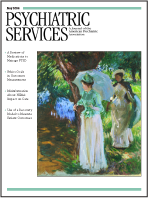Training in Transcultural Psychiatry to Reduce Racial and Ethnic Disparities
To the Editor: We read with interest the article by Jayme L. Opolka, M.S., and colleagues (1) in the February issue about disparities in antipsychotic prescribing between African-American and white patients. Not surprisingly, the findings are consistent with those of previous studies showing that members of ethnic minority groups face many barriers in terms of diagnosis and treatment. Such findings are not unique to the United States. A survey conducted in England found that Africans and other patients from ethnic minority groups were more likely than white patients to be given a diagnosis of schizophrenia (2). A review of the literature on health care for adolescents by Elster and associates (3) noted racial and ethnic disparities that were independent of socioeconomic status.
Attributing these biases to racism would be simplistic and unproductive. Bhugra and Bhui (4) have argued that blunt and indiscriminate application of the word "racism" perpetuates confusion about the meaning of the term, the processes involved, and the degree to which individuals are aware of the impact of their actions.
How do we solve the problem of racial and ethnic disparities? The answer lies in the results of a survey in England that showed that cultural and racial issues were not adequately addressed during the training of clinicians (2). The survey found that incorporating transcultural psychiatry into undergraduate and postgraduate medical education curricula would reduce racial stereotypes, which could help change the behavior and practices of clinicians. The survey's findings lend support to the recommendation by Cooper-Patrick and coauthors (5) for increasing patients' involvement in and satisfaction with care and improving health outcomes by enhancing cross-cultural communication between primary care physicians and patients and ensuring patients' access to a diverse group of physicians.
Dr. Adetunji is affiliated with the department of psychiatry at Drexel University College of Medicine in Philadelphia. Dr. Osinowo is with Northcoast Behavioral Healthcare and the department of psychiatry at the Medical College of Ohio in Toledo. Dr. Williams is with the department of psychiatry at the University of Illinois at Chicago.
1. Opolka JL, Rascati KL, Brown CM, et al: Ethnicity and prescription patterns for haloperidol, risperidone, and olanzapine. Psychiatric Services 55:151–156, 2004Link, Google Scholar
2. Adetunji BA: Racism in psychiatric practice: comparative study of the perception of Caucasian versus non-Caucasian mental health professionals of some key issues. Master's dissertation, department of psychiatry, University of London, 1997Google Scholar
3. Elster A, Jaroski J, VanGeest J, et al: Racial and ethnic disparities in health care for adolescents: a systematic review of the literature. Archives of Pediatric and Adolescent Medicine 157:850–851, 2003Crossref, Medline, Google Scholar
4. Bhugra D, Bhui K: Racism in psychiatry: paradigm lost, paradigm regained. International Review of Psychiatry 11:236–243, 1999Crossref, Medline, Google Scholar
5. Cooper-Patrick L, Gallo JJ, Gonzalez JJ, et al: Race, gender, and partnership in the patient-physician relationship. JAMA 282:583–589, 1999Crossref, Medline, Google Scholar



